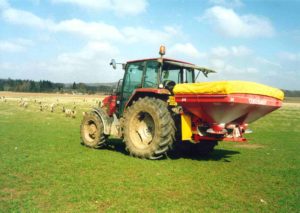How To Fertilise Paddocks?
6 July 2017 The little and often approach to fertilising with any nutrient (but particularly N and S as they are so mobile in soil and easily lost to drainage and/or atmosphere) is the most efficient way to devise a fertiliser programme. It is the most efficient for nutrient use and for grass growth. So the biological answer to how often to apply N on a rotational system is – apply to every paddock as soon as the animals move to the next paddock. The whole point of a paddock grazing system is to grow and utilise more grass and therefore get more LWG from grazed grass. A practical compromise would be to fertilise two paddocks at a time, but then the paddock that has been waiting for fertiliser for 6 days has lost 6 days of potential growth. Stepping back even more and fertilising the whole grazing platform every 3 or 4 weeks is an option, but that also will compromise optimum grass growth and nutrient use efficiency.
The little and often approach to fertilising with any nutrient (but particularly N and S as they are so mobile in soil and easily lost to drainage and/or atmosphere) is the most efficient way to devise a fertiliser programme. It is the most efficient for nutrient use and for grass growth. So the biological answer to how often to apply N on a rotational system is – apply to every paddock as soon as the animals move to the next paddock. The whole point of a paddock grazing system is to grow and utilise more grass and therefore get more LWG from grazed grass. A practical compromise would be to fertilise two paddocks at a time, but then the paddock that has been waiting for fertiliser for 6 days has lost 6 days of potential growth. Stepping back even more and fertilising the whole grazing platform every 3 or 4 weeks is an option, but that also will compromise optimum grass growth and nutrient use efficiency.
What Nutrients To Spread And When?
There really is no difference in the fertiliser N (or S, P and K) recommendations for a set-stocked or a rotational grazing system. The rotational grazing system will grow more grass, because the grass is being defoliated at the optimum (3 leaf) stage that encourages high intakes (and therefore potential utilisation) and optimum regrowth. This means that farmers switching to a rotational system should review their nutrient use (soil analysis, liming, manures and bagged fertiliser). If the review says they were applying the right amounts on a traditional set-stocked system, then there is no change to be made other than to go more little and often. If the review says that the N inputs were too much or too little, then make the change.
How Much To Spread And When?
If the emphasis is on spring growth for spring calving, then more can be put on in the spring applications to maximise grass growth at this time – so first two applications might be 40 kg N/ha (32 units/acre), but no more than this. If the target is for more grass mid-season, first application or two might be 30 kg N/ha (24 units/acre), rising to 40 kg N/ha at third and fourth applications, then scaling back. For many a flat profile of 30 kg N/ha for each rotation will suffice.
Phosphorus
If this is required then get it on with the first spring application as there will be a boost to early grass growth from early applied P.
Potassium
If it’s needed then get it on the previous autumn if soil indexes are very low, then more from mid-season onwards. If soil K is medium and applications are for maintenance, then get it on from mid-season onwards.
Sulphur
If needed on a grazing system, it should go on with every N application.
Basil Lowman, basil.lowman@sac.co.uk
Sign up to the FAS newsletter
Receive updates on news, events and publications from Scotland’s Farm Advisory Service
